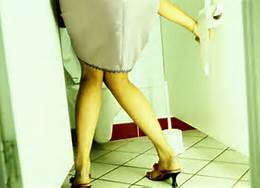Urinary Incontinence

|
Voltaire |
Millions of women experience involuntary loss of urine called urinary incontinence (UI). Some women may lose a few drops of urine while running or coughing. Others may feel a strong, sudden urge to urinate just before losing a large amount of urine. Many women experience both symptoms. UI can be slightly bothersome or totally debilitating. For some women, the risk of public embarrassment keeps them from enjoying many activities with their family and friends. Urine loss can also occur during sexual activity and cause tremendous emotional distress.
Women experience UI twice as often as men. Pregnancy and childbirth, menopause, and the structure of the female urinary tract account for this difference. But both women and men can become incontinent from neurologic injury, birth defects, stroke, multiple sclerosis, and physical problems associated with aging.
Older women experience UI more often than younger women. But incontinence is not inevitable with age. UI is a medical problem. No single treatment works for everyone, but many women can find improvement without surgery.
Your bladder is a muscle shaped like a balloon. While the bladder stores urine, the muscle relaxes. When you go to the bathroom, the bladder muscle tightens to squeeze urine out of the bladder. Two sphincter muscles surround a tube called the urethra. Urine leaves your bladder through this tube. The sphincter muscles relax during urination in order to allow urine to pass through the urethra. The sphincters keep the urethra closed by squeezing like rubber bands. Pelvic floor muscles under the bladder also help keep the urethra closed. Strengthening your pelvic floor is essential – it can improve your sex life, flatten your belly, and will certainly take care of your bladder. Your hip bones are part of the pelvic area. At the bottom of the pelvis, several layers of muscle stretch between your legs. The muscles attach to the front, back, and sides of the pelvis bone. Two pelvic muscles do most of the work. The biggest one stretches like a hammock. The other is shaped like a triangle. These muscles prevent the leaking of urine.
When the bladder is full, nerves in your bladder signal the brain. That’s when you get the urge to go to the bathroom. Once you reach the toilet, your brain tells the sphincter and pelvic floor muscles to relax. This allows urine to pass through the urethra. The brain signal also tells the bladder to tighten up. This squeezes urine out of the bladder. Bladder control means you urinate only when you want to. For good bladder control, all parts of your urinary system must work together.
you we’ll learn about:
- What muscles and nerves should work for good bladder control
- What are the types of urinary incontinence
- What is the effect of fluids












